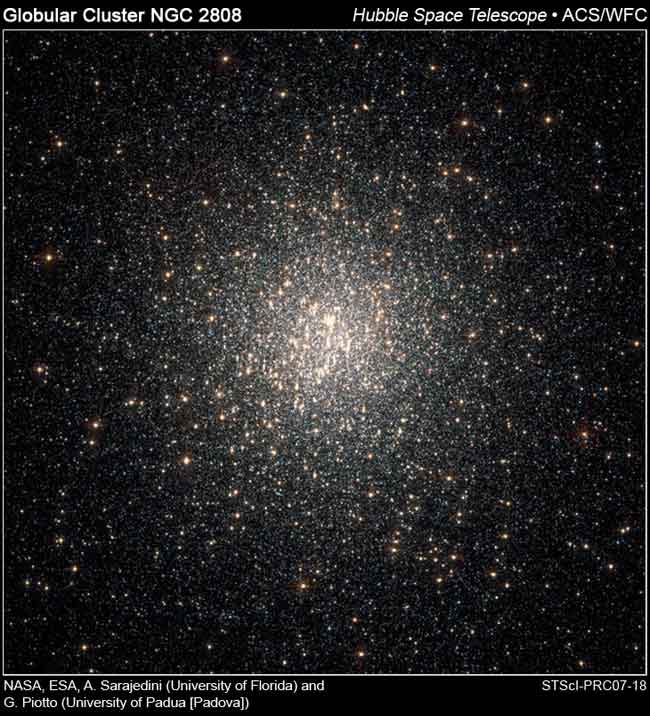
The long-held belief that globular star clusters form in asingle boom has been challenged by new findings.
Make it boom, boom, boom.
New observations by NASA's Hubble Space Telescope of the globular clusterNGC 2808 provides evidence that star birth occurred in three bouts,astronomers said today. Three generations of stars formed very early in thecluster's life, a discovery with deep cosmological implications.
Globularclusters are ancient. Those in our MilkyWay Galaxy were formed as the galaxy formed, billions of years ago. Thetypically hundreds of thousands of stars swirl in a cluster, all held togetherby their collective gravity.
"The standard picture of a globular cluster is that allof its stars formed at the same time, in the same place, and from the samematerial..." said team member Luigi Bedin of the European Space Agency. "Wewere very surprised to find several distinct populations... All of the stars wereborn within 200 million years very early in the life of the12.5-billion-year-old massive cluster."
Hubble's AdvancedCamera for Surveys recorded the colors of the cluster stars, showing threedistinct populations of slightly different colors, suggesting that successivegenerations contain a different elemental blend.
One assumption, said team member Ivan King of the Universityof Washington in Seattle, is that "the amount of helium increases witheach generation of stars. Perhaps massive star clusters like NGC 2808 hold ontoenough gas to ignite a rapid succession of stars."
Get the Space.com Newsletter
Breaking space news, the latest updates on rocket launches, skywatching events and more!
The star birth in general is a cyclic affair. Stars areborn, and many die explosively, and then new starbirth is driven by shock wavesfrom these exploding supernovas. Stellar winds from other giant stars compressthe gas and help make new stars out of it, King explained. The first stars werepretty much all hydrogen, but then they forge heavier elements, and gas ofnewer stars is increasingly enriched in helium from previous generations.
Astronomers commonly assume that globular clusters produceonly one stellar generation, because energy radiating from the first starswould clear most of the residual gas needed to make more stars. But a largecluster like NGC 2808, two to three times more massive than a typical globularcluster, may have enough gravity to retain that gas, enriched by helium fromthe first stars. NGC 2808 is one of the most massive globular clusters in ourMilky Way Galaxy, containing more than a million stars.
A possible explanation for the multiple stellar populationsis that NGC 2808 may not be a globular cluster. It may be a dwarfgalaxy that was stripped of most of its material by our galaxy'sgravitational effects.
Multiple stellar populations may be a typical occurrence inother massive clusters.
"This discovery shows that the study of stellarpopulations in globular clusters now opens up in a new direction," saidKing.
- Age Of Universe Hidden in Star Clusters of Milky Way
- Nearest Galaxy Ripped from Another, Study Suggests
- Hubble Sees Galactic Evolution in Odd Stellar Collection
Join our Space Forums to keep talking space on the latest missions, night sky and more! And if you have a news tip, correction or comment, let us know at: community@space.com.










